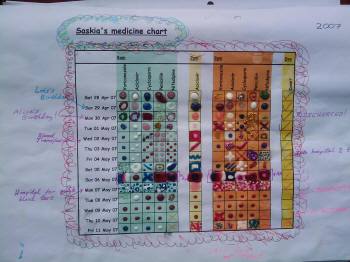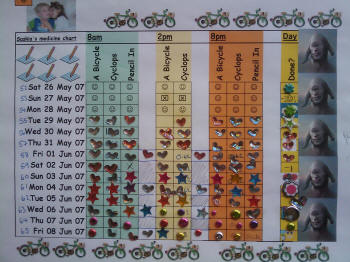

Back to index page
Taking those Medicines
Between May and October, after Saskia left hospital, we reckon we gave her about 1200 doses of medicine orally! This was no fun for anyone, as you can see from the blogs.
To help us as parents remember where we were and to help Saskia get some feeling of achievement in the unpleasant business we created a chart to map progress. As a family we're not really into "sticker-charts" in general, but these charts did help us slightly in getting those medicines down. The chart started out quite simply . . .
| 8am | 2pm | 8pm | Day | |||||||||
| Voriconazole | Aciclovir | Cyclosporin | Penicillin | Nifedipine | Aciclovir | Voriconazole | Aciclovir | Cyclosporin | Penicillin | Nifedipine | Done? | |
| Sat 28 Apr 07 | J | J | J | J | J | J | ||||||
| Sun 29 Apr 07 | ||||||||||||
| Mon 30 Apr 07 | ||||||||||||
| Tue 01 May 07 | ||||||||||||
| Wed 02 May 07 | ||||||||||||
| Thu 03 May 07 | ||||||||||||
| Fri 04 May 07 | ||||||||||||
| Sat 05 May 07 | ||||||||||||
| Sun 06 May 07 | ||||||||||||
| Mon 07 May 07 | ||||||||||||
| Tue 08 May 07 | ||||||||||||
| Wed 09 May 07 | ||||||||||||
| Thu 10 May 07 | ||||||||||||
| Fri 11 May 07 |
. . . but quite soon we were inventing ever more fancy sheets, with special gel pens and stickers. You might notice that each of the medicines took on a weird name all of it's own, with pictures to match . . .
Every one of those dots in the pictures above is a dose taken. And, especially to start with, Saskia REALLY did not like taking them. Although she's always been great at taking medicines before, after seemingly endless weeks in hospital she had grown strongly resistant to taking more and more drugs at home. Some of them (the anti-fungal ones) she particularly disliked and she would sometimes vomit them up. Of course, the painful thing then is that we'd have to persuade her to take them again: all of them she'd thrown up! At the start, getting a batch of 5 medicines down her would sometimes take between 2 and 3 hours of persuasion, threats and enticement. And with this 5 medicine batch happening twice a day, plus one extra drug at lunch time, the days at home were tough. At least in the early weeks Dad was at home to help out, but when he went back to work Mum ploughed through the medicines with Saskia every day. To get a better idea of the intimidating magnitude of this task, look at the medicine charts in their scary entirety . . .
Now, it wasn't just the medicine charts which helped us get that medicine down. Worth of note are THE FISH. They are fairly simple little soft rubber toys, each around the size of your thumb below the last joint. The special thing about them is that they come in packets of 6, with each fish being a slightly different shape. They are easy enough to discern by the eye, but could you do it blindfold? If you saw someone wearing a blindfold identifying each of these fish by touch alone would that not be an amazing trick? A trick worthy perhaps of taking a dose of medicine if that trick were to be performed correctly, with each of the 6 fish correctly identified without fault? No? Well, with enough theatre you'd be surprised what can be achieved. Dad doing his fish-trick certainly got us through many of the tougher first weeks of that medicine. (Ever so slightly.) And here they are . . .
Easy, I hear you cry? Well get some and try it!
Saskia will probably be taking 2 doses of penicillin every day for the rest of her life. This is to help protect her against diseases like pneumonia since although her bone marrow is great at fighting infections, there's a chance that her spleen (which is the organ which helps fight these type of diseases) may be damaged. Since we can't tell, it's standard practice to put post-transplant patients on this low-impact, preventative drug.